Project Management: New Product Development Model Analysis Report
VerifiedAdded on 2023/03/21
|32
|5579
|49
Report
AI Summary
This report analyzes the new product-development model, a globally recognized framework for introducing new products to the market. The model emphasizes simplicity and provides easy-to-understand steps, incorporating creativity in sourcing new information. The report details each step of the process, from idea generation and screening to concept development, market strategy, business analysis, product development, market testing, and commercialization. It also includes risk analysis, a Gantt chart for project management, a RACI matrix, and a stakeholder management strategy, all within a budget of £2.5 million for a food industry product launch planned for the next winter. The analysis considers PESTLE factors and various methodologies to ensure high consumer acceptability of the new product. Desklib provides students access to this and many other solved assignments.

PROJECT MANAGEMENT 1
PROJECT MANAGEMENT
University
Name
Course
PROJECT MANAGEMENT
University
Name
Course
Paraphrase This Document
Need a fresh take? Get an instant paraphrase of this document with our AI Paraphraser

PROJECT MANAGEMENT 2
Abstract
The purpose of this report is analyze a new product-development model which is a model with
fame globally regarding the development as well as the introduction of any new product to the
target segment of the global market. As a model, new product-development is characterized by
simplicity as it provides easy-to-understand steps. With creativity being the adopted buzzword,
all the organization have adopted it in its various day-to-day operations including in devising
ways of sourcing new information concerning product development . The process of coming up
with a new product invoves various steps with each of them playing a critical role which if
abandoned, the proccess is rendered incomplete and not functional. Each of these steps or
methodologies has tools for doing its role in an effective manner. Whatever the methodology
employed by any step,it should maintain the main goals of the organization in coming up with a
product that receive high consumer acceptability.
Abstract
The purpose of this report is analyze a new product-development model which is a model with
fame globally regarding the development as well as the introduction of any new product to the
target segment of the global market. As a model, new product-development is characterized by
simplicity as it provides easy-to-understand steps. With creativity being the adopted buzzword,
all the organization have adopted it in its various day-to-day operations including in devising
ways of sourcing new information concerning product development . The process of coming up
with a new product invoves various steps with each of them playing a critical role which if
abandoned, the proccess is rendered incomplete and not functional. Each of these steps or
methodologies has tools for doing its role in an effective manner. Whatever the methodology
employed by any step,it should maintain the main goals of the organization in coming up with a
product that receive high consumer acceptability.
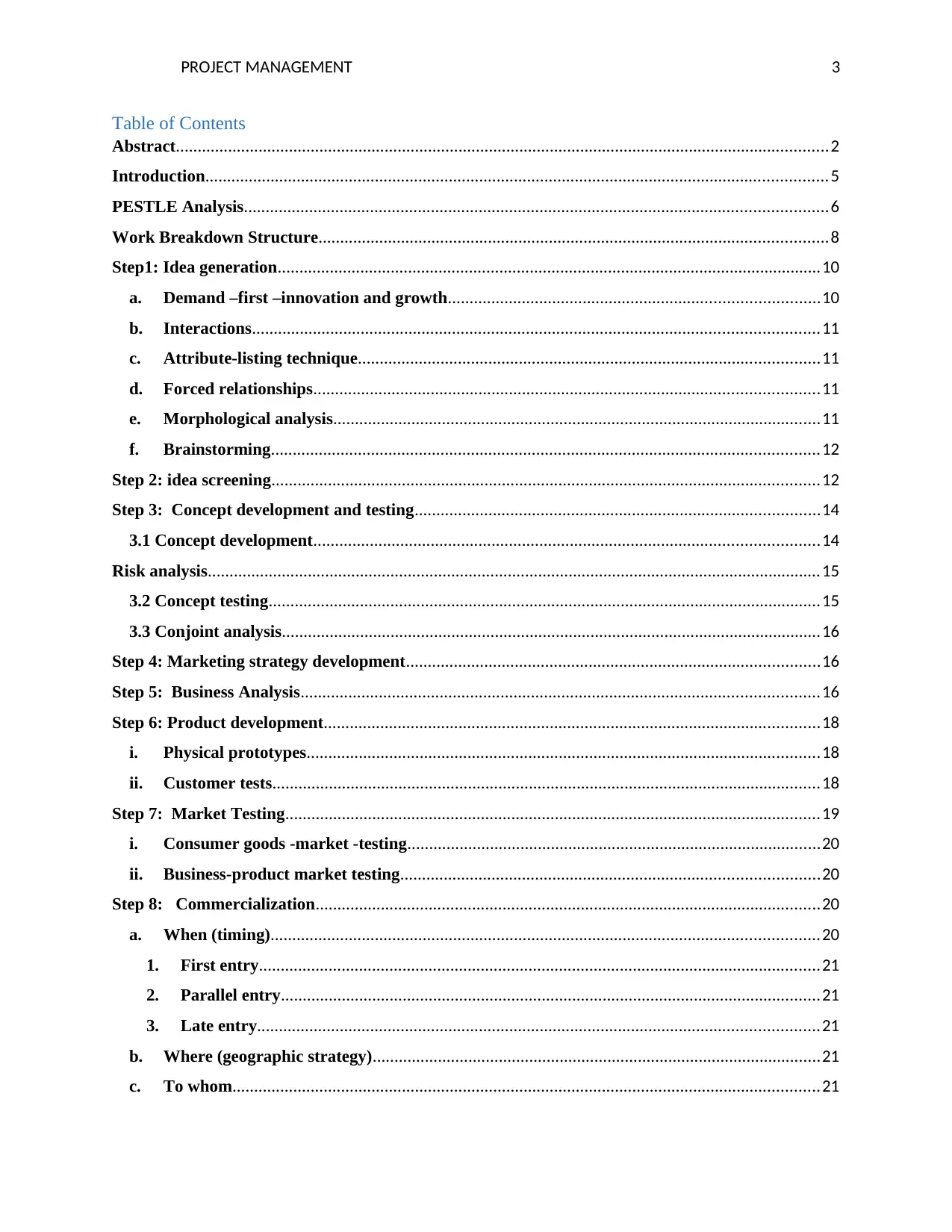
PROJECT MANAGEMENT 3
Table of Contents
Abstract......................................................................................................................................................2
Introduction...............................................................................................................................................5
PESTLE Analysis......................................................................................................................................6
Work Breakdown Structure.....................................................................................................................8
Step1: Idea generation.............................................................................................................................10
a. Demand –first –innovation and growth.....................................................................................10
b. Interactions..................................................................................................................................11
c. Attribute-listing technique..........................................................................................................11
d. Forced relationships....................................................................................................................11
e. Morphological analysis................................................................................................................11
f. Brainstorming..............................................................................................................................12
Step 2: idea screening..............................................................................................................................12
Step 3: Concept development and testing.............................................................................................14
3.1 Concept development....................................................................................................................14
Risk analysis.............................................................................................................................................15
3.2 Concept testing...............................................................................................................................15
3.3 Conjoint analysis............................................................................................................................16
Step 4: Marketing strategy development...............................................................................................16
Step 5: Business Analysis.......................................................................................................................16
Step 6: Product development..................................................................................................................18
i. Physical prototypes......................................................................................................................18
ii. Customer tests..............................................................................................................................18
Step 7: Market Testing...........................................................................................................................19
i. Consumer goods -market -testing...............................................................................................20
ii. Business-product market testing................................................................................................20
Step 8: Commercialization....................................................................................................................20
a. When (timing)..............................................................................................................................20
1. First entry.................................................................................................................................21
2. Parallel entry............................................................................................................................21
3. Late entry.................................................................................................................................21
b. Where (geographic strategy).......................................................................................................21
c. To whom.......................................................................................................................................21
Table of Contents
Abstract......................................................................................................................................................2
Introduction...............................................................................................................................................5
PESTLE Analysis......................................................................................................................................6
Work Breakdown Structure.....................................................................................................................8
Step1: Idea generation.............................................................................................................................10
a. Demand –first –innovation and growth.....................................................................................10
b. Interactions..................................................................................................................................11
c. Attribute-listing technique..........................................................................................................11
d. Forced relationships....................................................................................................................11
e. Morphological analysis................................................................................................................11
f. Brainstorming..............................................................................................................................12
Step 2: idea screening..............................................................................................................................12
Step 3: Concept development and testing.............................................................................................14
3.1 Concept development....................................................................................................................14
Risk analysis.............................................................................................................................................15
3.2 Concept testing...............................................................................................................................15
3.3 Conjoint analysis............................................................................................................................16
Step 4: Marketing strategy development...............................................................................................16
Step 5: Business Analysis.......................................................................................................................16
Step 6: Product development..................................................................................................................18
i. Physical prototypes......................................................................................................................18
ii. Customer tests..............................................................................................................................18
Step 7: Market Testing...........................................................................................................................19
i. Consumer goods -market -testing...............................................................................................20
ii. Business-product market testing................................................................................................20
Step 8: Commercialization....................................................................................................................20
a. When (timing)..............................................................................................................................20
1. First entry.................................................................................................................................21
2. Parallel entry............................................................................................................................21
3. Late entry.................................................................................................................................21
b. Where (geographic strategy).......................................................................................................21
c. To whom.......................................................................................................................................21
⊘ This is a preview!⊘
Do you want full access?
Subscribe today to unlock all pages.

Trusted by 1+ million students worldwide

PROJECT MANAGEMENT 4
d. How...............................................................................................................................................22
Gant chart................................................................................................................................................22
Gant chart for the project.......................................................................................................................22
Risk management strategy......................................................................................................................22
RACI Matrix............................................................................................................................................23
Stakeholder Management Strategy........................................................................................................23
Conclusion................................................................................................................................................24
References................................................................................................................................................25
Appendixes...............................................................................................................................................29
d. How...............................................................................................................................................22
Gant chart................................................................................................................................................22
Gant chart for the project.......................................................................................................................22
Risk management strategy......................................................................................................................22
RACI Matrix............................................................................................................................................23
Stakeholder Management Strategy........................................................................................................23
Conclusion................................................................................................................................................24
References................................................................................................................................................25
Appendixes...............................................................................................................................................29
Paraphrase This Document
Need a fresh take? Get an instant paraphrase of this document with our AI Paraphraser
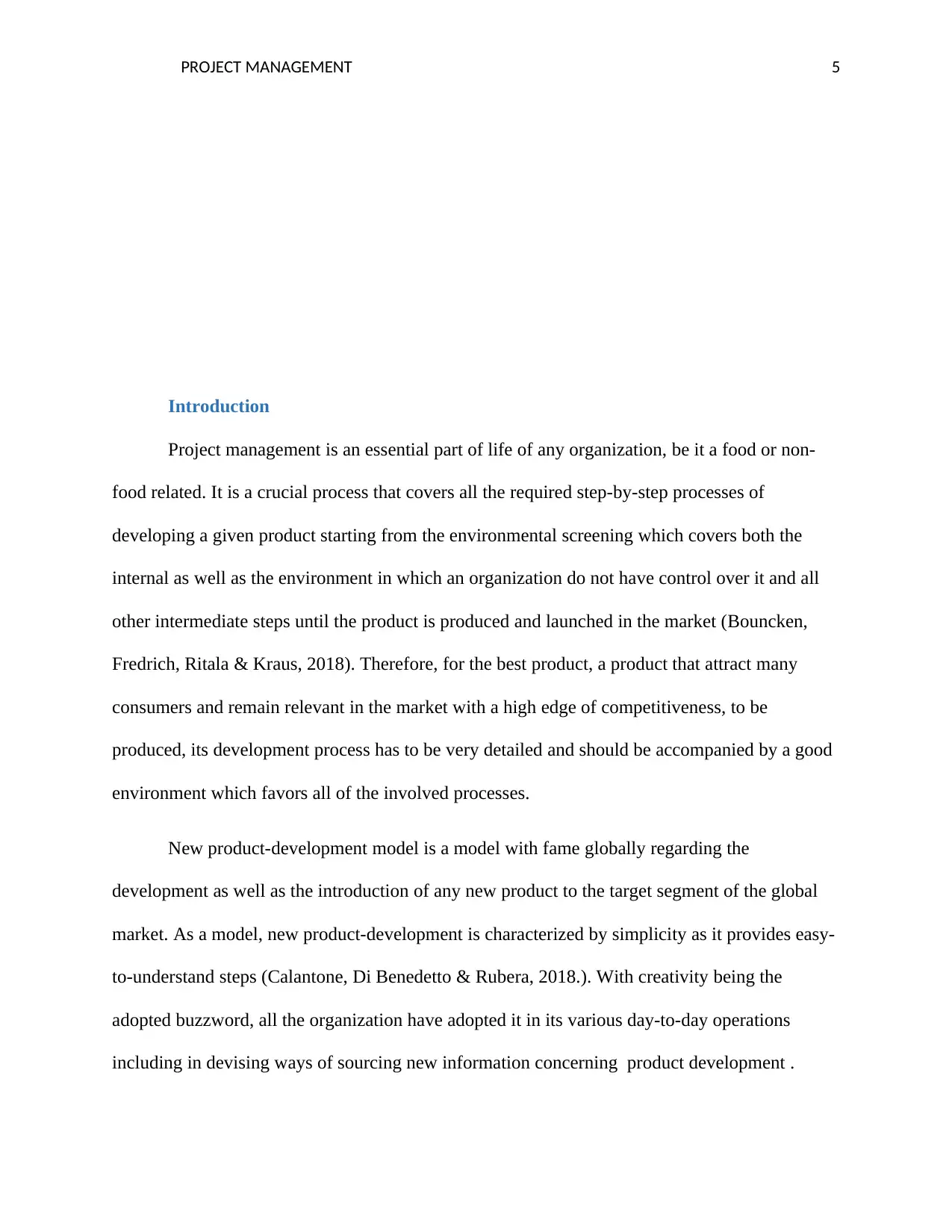
PROJECT MANAGEMENT 5
Introduction
Project management is an essential part of life of any organization, be it a food or non-
food related. It is a crucial process that covers all the required step-by-step processes of
developing a given product starting from the environmental screening which covers both the
internal as well as the environment in which an organization do not have control over it and all
other intermediate steps until the product is produced and launched in the market (Bouncken,
Fredrich, Ritala & Kraus, 2018). Therefore, for the best product, a product that attract many
consumers and remain relevant in the market with a high edge of competitiveness, to be
produced, its development process has to be very detailed and should be accompanied by a good
environment which favors all of the involved processes.
New product-development model is a model with fame globally regarding the
development as well as the introduction of any new product to the target segment of the global
market. As a model, new product-development is characterized by simplicity as it provides easy-
to-understand steps (Calantone, Di Benedetto & Rubera, 2018.). With creativity being the
adopted buzzword, all the organization have adopted it in its various day-to-day operations
including in devising ways of sourcing new information concerning product development .
Introduction
Project management is an essential part of life of any organization, be it a food or non-
food related. It is a crucial process that covers all the required step-by-step processes of
developing a given product starting from the environmental screening which covers both the
internal as well as the environment in which an organization do not have control over it and all
other intermediate steps until the product is produced and launched in the market (Bouncken,
Fredrich, Ritala & Kraus, 2018). Therefore, for the best product, a product that attract many
consumers and remain relevant in the market with a high edge of competitiveness, to be
produced, its development process has to be very detailed and should be accompanied by a good
environment which favors all of the involved processes.
New product-development model is a model with fame globally regarding the
development as well as the introduction of any new product to the target segment of the global
market. As a model, new product-development is characterized by simplicity as it provides easy-
to-understand steps (Calantone, Di Benedetto & Rubera, 2018.). With creativity being the
adopted buzzword, all the organization have adopted it in its various day-to-day operations
including in devising ways of sourcing new information concerning product development .
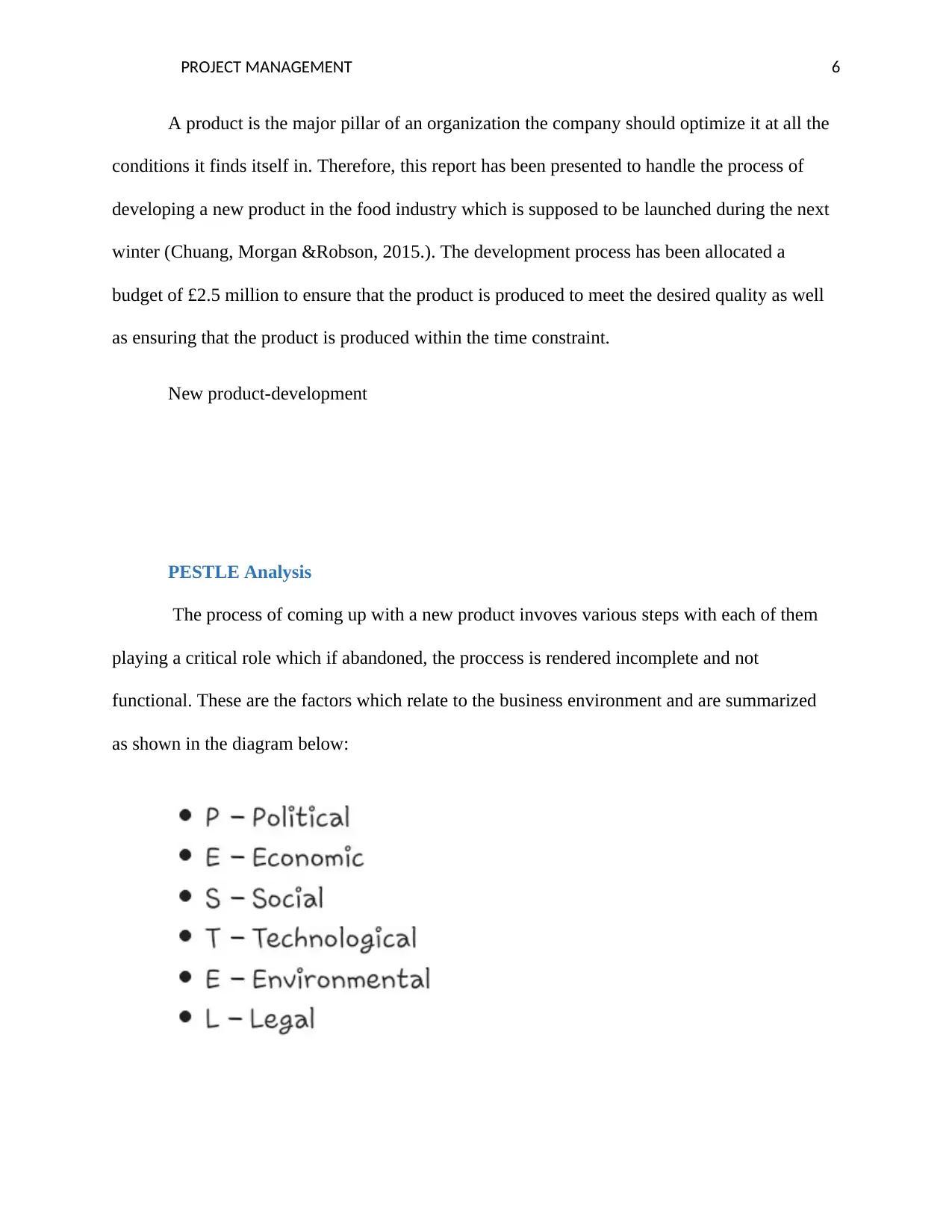
PROJECT MANAGEMENT 6
A product is the major pillar of an organization the company should optimize it at all the
conditions it finds itself in. Therefore, this report has been presented to handle the process of
developing a new product in the food industry which is supposed to be launched during the next
winter (Chuang, Morgan &Robson, 2015.). The development process has been allocated a
budget of £2.5 million to ensure that the product is produced to meet the desired quality as well
as ensuring that the product is produced within the time constraint.
New product-development
PESTLE Analysis
The process of coming up with a new product invoves various steps with each of them
playing a critical role which if abandoned, the proccess is rendered incomplete and not
functional. These are the factors which relate to the business environment and are summarized
as shown in the diagram below:
A product is the major pillar of an organization the company should optimize it at all the
conditions it finds itself in. Therefore, this report has been presented to handle the process of
developing a new product in the food industry which is supposed to be launched during the next
winter (Chuang, Morgan &Robson, 2015.). The development process has been allocated a
budget of £2.5 million to ensure that the product is produced to meet the desired quality as well
as ensuring that the product is produced within the time constraint.
New product-development
PESTLE Analysis
The process of coming up with a new product invoves various steps with each of them
playing a critical role which if abandoned, the proccess is rendered incomplete and not
functional. These are the factors which relate to the business environment and are summarized
as shown in the diagram below:
⊘ This is a preview!⊘
Do you want full access?
Subscribe today to unlock all pages.

Trusted by 1+ million students worldwide
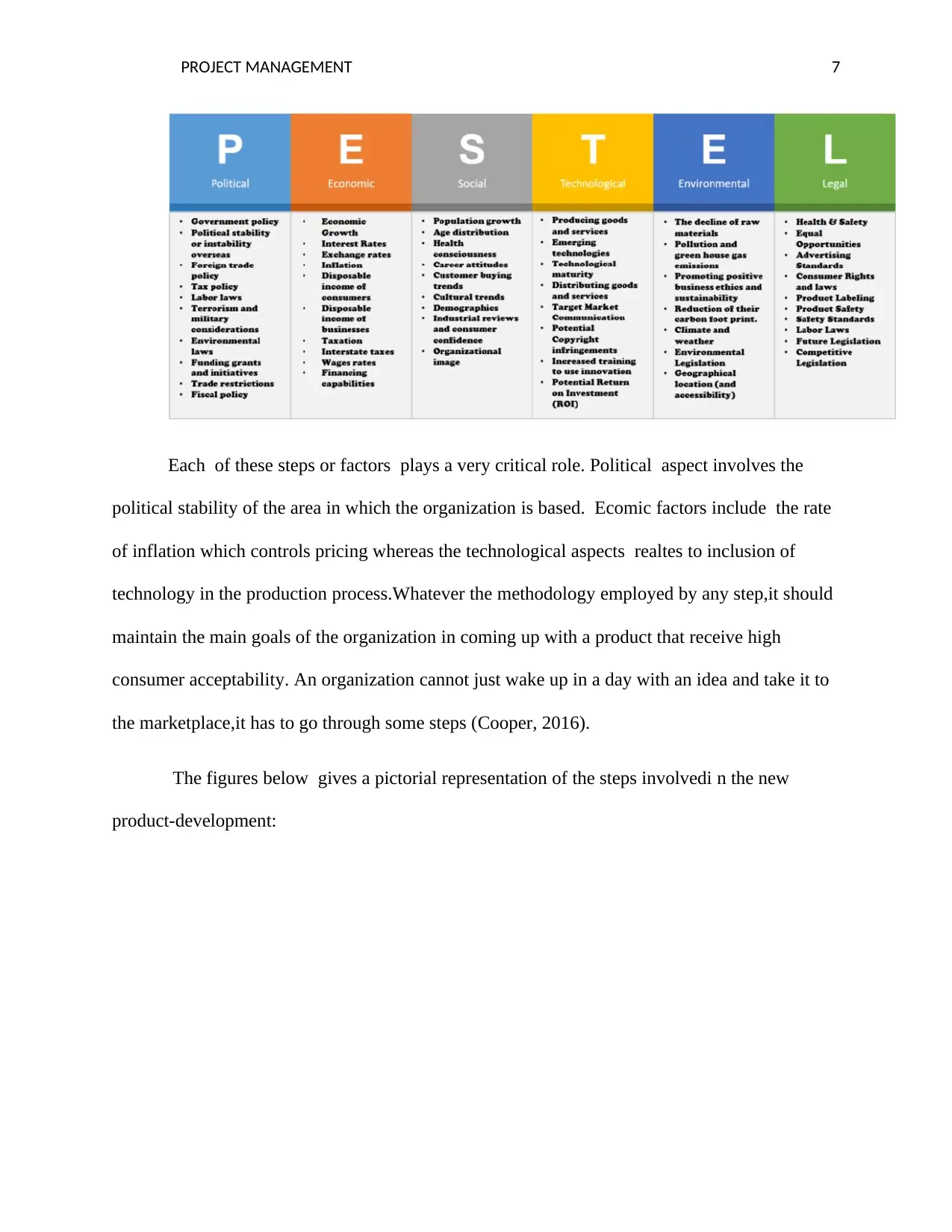
PROJECT MANAGEMENT 7
Each of these steps or factors plays a very critical role. Political aspect involves the
political stability of the area in which the organization is based. Ecomic factors include the rate
of inflation which controls pricing whereas the technological aspects realtes to inclusion of
technology in the production process.Whatever the methodology employed by any step,it should
maintain the main goals of the organization in coming up with a product that receive high
consumer acceptability. An organization cannot just wake up in a day with an idea and take it to
the marketplace,it has to go through some steps (Cooper, 2016).
The figures below gives a pictorial representation of the steps involvedi n the new
product-development:
Each of these steps or factors plays a very critical role. Political aspect involves the
political stability of the area in which the organization is based. Ecomic factors include the rate
of inflation which controls pricing whereas the technological aspects realtes to inclusion of
technology in the production process.Whatever the methodology employed by any step,it should
maintain the main goals of the organization in coming up with a product that receive high
consumer acceptability. An organization cannot just wake up in a day with an idea and take it to
the marketplace,it has to go through some steps (Cooper, 2016).
The figures below gives a pictorial representation of the steps involvedi n the new
product-development:
Paraphrase This Document
Need a fresh take? Get an instant paraphrase of this document with our AI Paraphraser
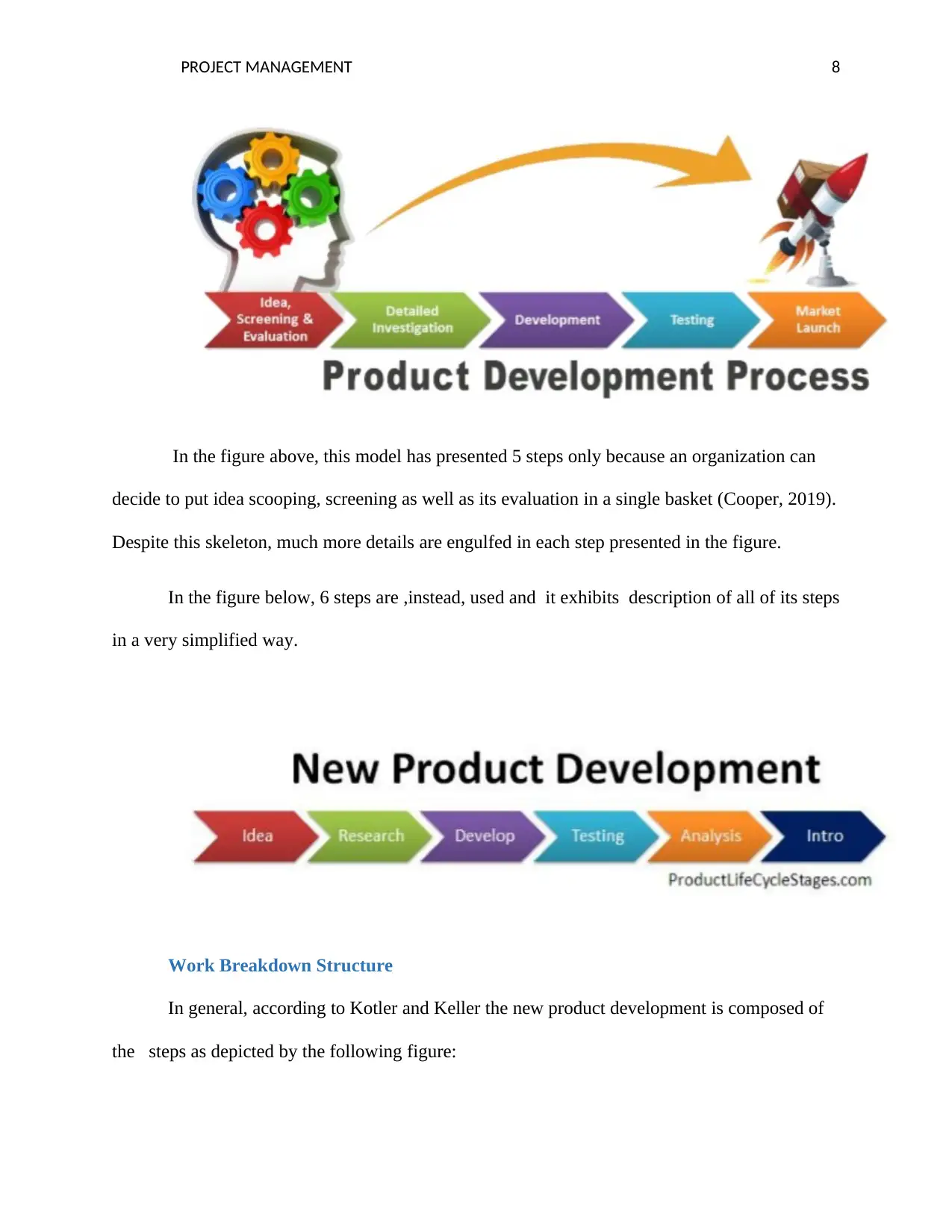
PROJECT MANAGEMENT 8
In the figure above, this model has presented 5 steps only because an organization can
decide to put idea scooping, screening as well as its evaluation in a single basket (Cooper, 2019).
Despite this skeleton, much more details are engulfed in each step presented in the figure.
In the figure below, 6 steps are ,instead, used and it exhibits description of all of its steps
in a very simplified way.
Work Breakdown Structure
In general, according to Kotler and Keller the new product development is composed of
the steps as depicted by the following figure:
In the figure above, this model has presented 5 steps only because an organization can
decide to put idea scooping, screening as well as its evaluation in a single basket (Cooper, 2019).
Despite this skeleton, much more details are engulfed in each step presented in the figure.
In the figure below, 6 steps are ,instead, used and it exhibits description of all of its steps
in a very simplified way.
Work Breakdown Structure
In general, according to Kotler and Keller the new product development is composed of
the steps as depicted by the following figure:
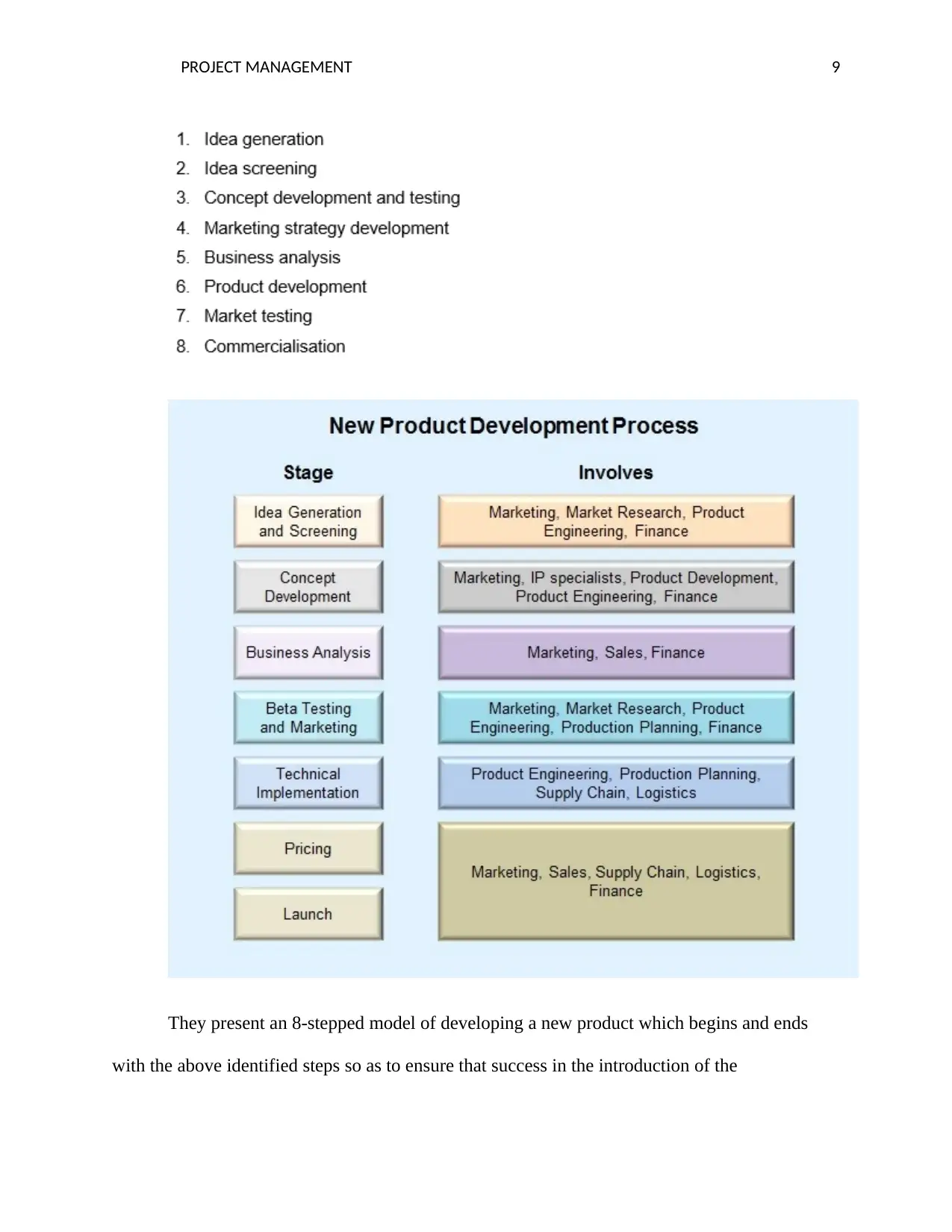
PROJECT MANAGEMENT 9
They present an 8-stepped model of developing a new product which begins and ends
with the above identified steps so as to ensure that success in the introduction of the
They present an 8-stepped model of developing a new product which begins and ends
with the above identified steps so as to ensure that success in the introduction of the
⊘ This is a preview!⊘
Do you want full access?
Subscribe today to unlock all pages.

Trusted by 1+ million students worldwide
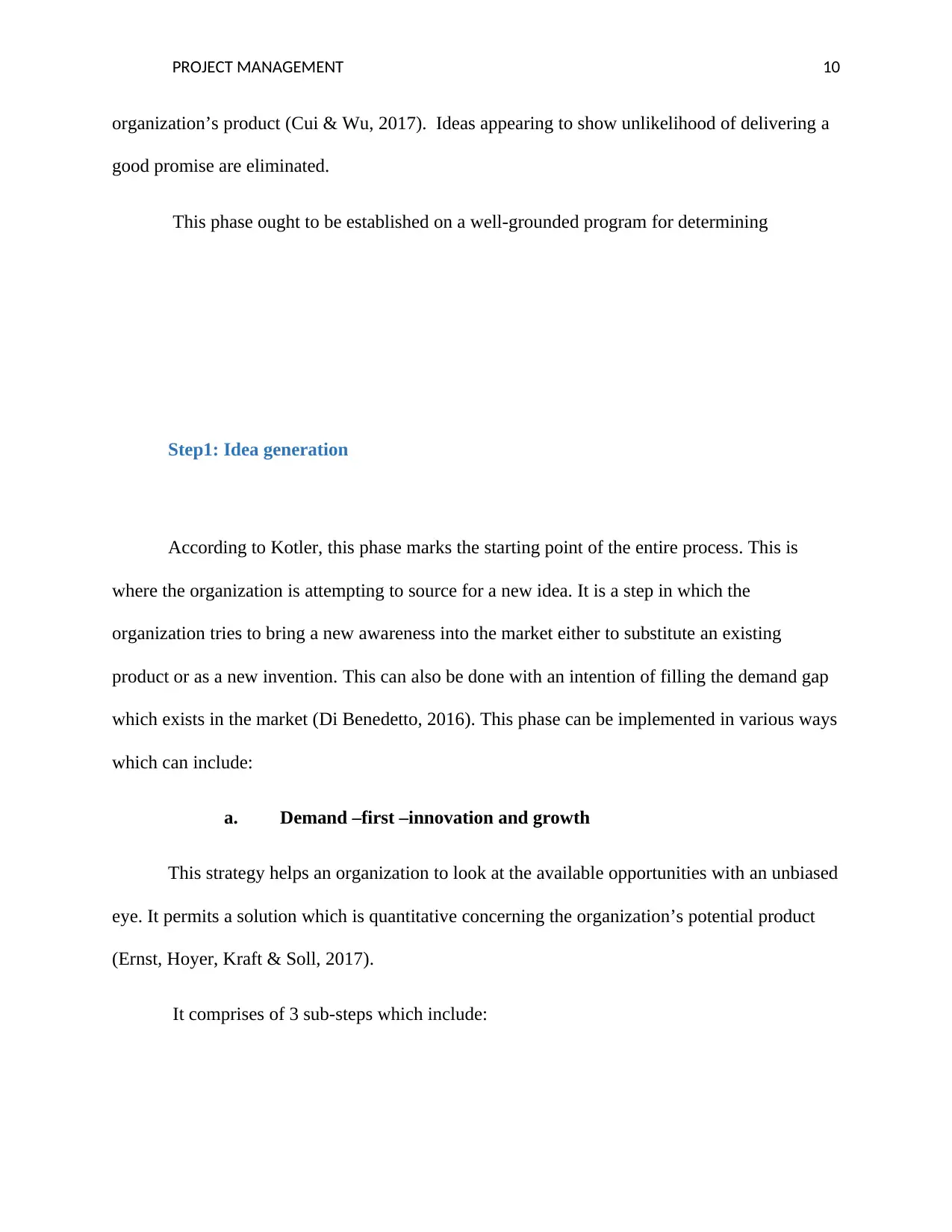
PROJECT MANAGEMENT 10
organization’s product (Cui & Wu, 2017). Ideas appearing to show unlikelihood of delivering a
good promise are eliminated.
This phase ought to be established on a well-grounded program for determining
Step1: Idea generation
According to Kotler, this phase marks the starting point of the entire process. This is
where the organization is attempting to source for a new idea. It is a step in which the
organization tries to bring a new awareness into the market either to substitute an existing
product or as a new invention. This can also be done with an intention of filling the demand gap
which exists in the market (Di Benedetto, 2016). This phase can be implemented in various ways
which can include:
a. Demand –first –innovation and growth
This strategy helps an organization to look at the available opportunities with an unbiased
eye. It permits a solution which is quantitative concerning the organization’s potential product
(Ernst, Hoyer, Kraft & Soll, 2017).
It comprises of 3 sub-steps which include:
organization’s product (Cui & Wu, 2017). Ideas appearing to show unlikelihood of delivering a
good promise are eliminated.
This phase ought to be established on a well-grounded program for determining
Step1: Idea generation
According to Kotler, this phase marks the starting point of the entire process. This is
where the organization is attempting to source for a new idea. It is a step in which the
organization tries to bring a new awareness into the market either to substitute an existing
product or as a new invention. This can also be done with an intention of filling the demand gap
which exists in the market (Di Benedetto, 2016). This phase can be implemented in various ways
which can include:
a. Demand –first –innovation and growth
This strategy helps an organization to look at the available opportunities with an unbiased
eye. It permits a solution which is quantitative concerning the organization’s potential product
(Ernst, Hoyer, Kraft & Soll, 2017).
It comprises of 3 sub-steps which include:
Paraphrase This Document
Need a fresh take? Get an instant paraphrase of this document with our AI Paraphraser

PROJECT MANAGEMENT 11
Demand landscape which is responsible for mapping the needs of a
consumer.
Opportunity space which uses different angles for the purpose of attaining
market perceptions.
Strategic blueprint which looks on ways in which the proposed product is
likely to fit into the market as well as the way it will differ with the products of a
competitor.
b. Interactions
Making interactions with stakeholders helps the organization in obtaining different
standpoints concerning the same problem. Use of interactions comes in different approaches
which might include interacting with the organization’s employees or the company’s customers
(Florén, Frishammar, Parida &Wincent, 2018).
c. Attribute-listing technique
This technique is used in this phase to list the major product’s attributes first.
After listing of the major attributes and in order to give the product its new shape, the
efforts are modified (Fuller, 2016).
d. Forced relationships
It is a technique used to list a variety of objects first after which a consideration to each
object. Each object is compared to the others so as to develop a multi-purpose product.
e. Morphological analysis
Demand landscape which is responsible for mapping the needs of a
consumer.
Opportunity space which uses different angles for the purpose of attaining
market perceptions.
Strategic blueprint which looks on ways in which the proposed product is
likely to fit into the market as well as the way it will differ with the products of a
competitor.
b. Interactions
Making interactions with stakeholders helps the organization in obtaining different
standpoints concerning the same problem. Use of interactions comes in different approaches
which might include interacting with the organization’s employees or the company’s customers
(Florén, Frishammar, Parida &Wincent, 2018).
c. Attribute-listing technique
This technique is used in this phase to list the major product’s attributes first.
After listing of the major attributes and in order to give the product its new shape, the
efforts are modified (Fuller, 2016).
d. Forced relationships
It is a technique used to list a variety of objects first after which a consideration to each
object. Each object is compared to the others so as to develop a multi-purpose product.
e. Morphological analysis

PROJECT MANAGEMENT 12
It is a methodology used to examine and identify essential scopes of a problem and its
relative relationships for the purpose of discovering a product’s best combination in the
manufacturing sector.
f. Brainstorming
This refers to the procedure used to deliberate a problem by a well-defined collection of
people so as to come up with various possible solutions and by which the paramount solution out
of those noted down is picked as well as being considered the most effective (Gao &
Bernard,2018).
Step 2: idea screening
This is the second phase of the new product-development and is all about driving a good
idea. It is a phase where development procedures are vetted through a unique form and to which
it attempts to answer certain inquiries about the product in the market. Such inquiries might be
whether: the product meets the desired necessity in the market, there is an effective means of
advertising the product, the product’s targeted sales capacity, sales progression and profit will be
met, the product will offer maximum mandate preferred in the market and whether the
manufacturing company have the necessary knowledge, skills, resources and capital required.
The inquiries attempted to be answered under this stage gives a breakthrough of thoughts
and identifying the ease in its prospects. Also, these inquiries must not only be answered by a yes
answer but also a no. However, an idea cannot just be categorized as a bad idea for having
majority of its answers to be negative (Gmelin &Seuring, 2018). This is because the same idea
It is a methodology used to examine and identify essential scopes of a problem and its
relative relationships for the purpose of discovering a product’s best combination in the
manufacturing sector.
f. Brainstorming
This refers to the procedure used to deliberate a problem by a well-defined collection of
people so as to come up with various possible solutions and by which the paramount solution out
of those noted down is picked as well as being considered the most effective (Gao &
Bernard,2018).
Step 2: idea screening
This is the second phase of the new product-development and is all about driving a good
idea. It is a phase where development procedures are vetted through a unique form and to which
it attempts to answer certain inquiries about the product in the market. Such inquiries might be
whether: the product meets the desired necessity in the market, there is an effective means of
advertising the product, the product’s targeted sales capacity, sales progression and profit will be
met, the product will offer maximum mandate preferred in the market and whether the
manufacturing company have the necessary knowledge, skills, resources and capital required.
The inquiries attempted to be answered under this stage gives a breakthrough of thoughts
and identifying the ease in its prospects. Also, these inquiries must not only be answered by a yes
answer but also a no. However, an idea cannot just be categorized as a bad idea for having
majority of its answers to be negative (Gmelin &Seuring, 2018). This is because the same idea
⊘ This is a preview!⊘
Do you want full access?
Subscribe today to unlock all pages.

Trusted by 1+ million students worldwide
1 out of 32
Related Documents
Your All-in-One AI-Powered Toolkit for Academic Success.
+13062052269
info@desklib.com
Available 24*7 on WhatsApp / Email
![[object Object]](/_next/static/media/star-bottom.7253800d.svg)
Unlock your academic potential
Copyright © 2020–2025 A2Z Services. All Rights Reserved. Developed and managed by ZUCOL.



